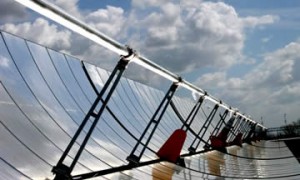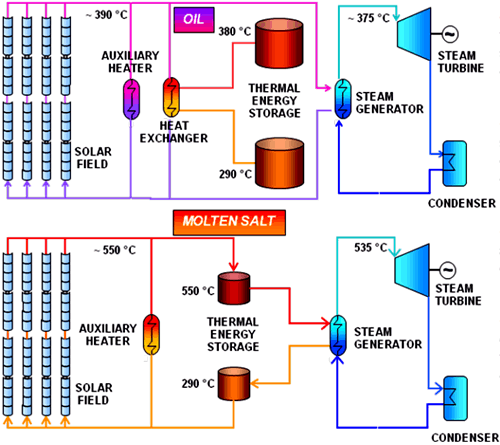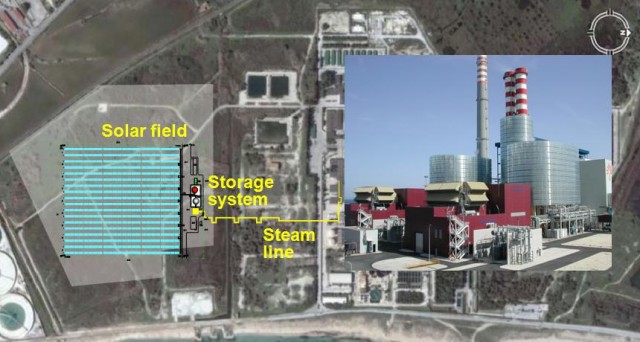 On 14 July 2010 the Italian utility Enel unveiled “Archimede”, the first Concentrating Solar Power (CSP) plant in the World to use molten salts for heat transfer and storage, and the first to be fully integrated to an existing combined-cycle power plant. Archimede is a 5 MW plant located in Priolo Gargallo (Sicily), within Europe’s largest petrochemical district. The breakthrough project was co-developed by Enel, one of World’s largest utilities, and ENEA, the Italian National Agency for New Technologies, Energy and Sustainable Economic Development.
On 14 July 2010 the Italian utility Enel unveiled “Archimede”, the first Concentrating Solar Power (CSP) plant in the World to use molten salts for heat transfer and storage, and the first to be fully integrated to an existing combined-cycle power plant. Archimede is a 5 MW plant located in Priolo Gargallo (Sicily), within Europe’s largest petrochemical district. The breakthrough project was co-developed by Enel, one of World’s largest utilities, and ENEA, the Italian National Agency for New Technologies, Energy and Sustainable Economic Development.
Several CSP plants already operate around the World, mainly in the US and Spain. They use synthetic oils to capture the Sun’s energy in the form of heat, by using mirrors that beam sunlight onto a pipe where pressurised oil heats up to around 390°C. A heat exchanger is then used to boil water and run a conventional steam turbine cycle. Older CSP plants can only operate at daytime – when direct sunlight is available -, an issue that has been dealt with in recent years by introducing heat storage, in the form of molten salts. Newer CSP plants, as the many under construction in Spain, use molten salts storage to extend the plants’ daily operating hours. Archimede is the first plant in the World to use molten salts not just to store heat but also to collect it from the Sun in the first place.
This is a competitive advantage, for a variety of reasons. Molten salts can operate at higher temperatures than oils (up to 550°C instead of 390°C), therefore increasing efficiency and power output of a plant. With the higher-temperature heat storage allowed by the direct use of salts, the plant can also extend its operating hours well further than an oil-operated CSP plant with molten salt storage, thus working 24 hours a day for several days in the absence of sun or during rainy days. This feature also enables a simplified plant design, as it avoids the need for oil-to-salts heat exchangers, and eliminates the safety and environmental concerns related to the use of oils (molten salts are cheap, non-toxic common fertilizers and do not catch fire, as opposed to synthetic oils currently used in CSP plants around the World). Last but not least, the higher temperatures reached by the molten salts enable the use of steam turbines at the standard pressure/temperature parameters as used in most common gas-cycle fossil power plants. This means that conventional power plants can be integrated – or, in perspective, replaced – with this technology without expensive retrofits to the existing assets.
So why hasn’t this technology come before? There are both political and technical issues behind this. Let’s start with politics. The concept dates back to 2001, when Italian nuclear physicist and Nobel prize winner Carlo Rubbia, ENEA’s President at the time, first started Research & Development on molten salt technology in Italy. Rubbia has been a preminent CSP advocate for a long time, and was forced to leave ENEA in 2005 after strong disagreements with the Italian Government and its lack of convincing R&D policies. He then moved to CIEMAT, the Spanish equivalent of ENEA. Under his guidance, Spain has now become World leader in the CSP industry. Luckily for the Italian industry, the Archimede project was not abandoned and ENEA continued its development till completion.
There are also various technical reasons that have prevented an earlier development of this new technology. Salts tend to solidify at temperatures around 220°C, which is a serious issue for the continuous operation of a plant. ENEA and Archimede Solar Energy, a private company focusing on receiver pipes, developed several patents in order to improve the pipes’ ability to absorbe heat, and the parabolic mirrors’ reflectivity, therefore maximising the heat transfer to the fluid carrier. The result of these and several other technological improvements is a top-notch World’s first power plant with a price tag of around 60 million euros. It’s a hefty price for a 5 MW power plant, even compared to other CSP plants, but there is overwhelming scope for a massive roll-out of this new technology at utility scale in sunny regions like Northern Africa, the Middle East, Australia, the US.
The Italian CSP association ANEST claims Italy could host 3-5,000 MW of CSP plants by 2020, with huge benefits also in terms of jobs creation and industrial know-how. A lot more can be achieved in the sun belt south of the Mediterranean Sea, and in the Middle East. If the roll out of solar photovoltaics in Italy is to offer any guidance (second largest market in the World in 2009), exciting times are ahead for Concentrating Solar Power.
Link to Enel Press Release










This blog post has now been published on Chris Goodall’s Carbon Commentary
and on: The Guardian website
My post also got published by: Solve Climate, Climate Progress
And quoted by: Energy Boom, Green Building Elements, CleanTechnica, The Green Optimistic
Several websites quoted or referenced my article through other websites… it’s now countless!
Pingback: Welcoming the World’s First Molten Salt Concentrating Solar Power Plant : Green Building Elements
Many comments to my article have emerged, particularly the ones on the Guardian website, regarding the price tag of the pilot plant. Some people seem overwhelmed by the cost of this pilot plant, and seem to overlook the fact that this is a World first. We could go into endless discussions as to where this new technology is going, so I thought I’d share more information from the ENEA programme, by showing their expectations for technical and financial performance, once R&D will have settled and full commercialisation has been achieved. The typical scenario for a 100MW stand-alone plant in Egypt would look like this:
Annual direct solar radiation: 2.900 kWh/(m2 year)
Total area occupied by the solar collectors: 67 ha
Total area occupied by the solar field: 134 ha
Nominal power output: 100 MW (Peak 485 MW)
Thermal storage capacity: 1.800 MWh
Net annual electricity produced: 369 GWh/year
Plant load factor: 42 %
Total Cost : 157 M€
Specific cost : 1.570 €/kWe
Service life: 25 years
Interest rate: 7%
Annual operating (O&M) costs: 2% of investment cost
Levelized Cost Of Electricity (LCOE): 4,5 €cents/kWh
Obviously, this can be scaled down or up according to needs, as much as the technical data can be changed. Some clients might want more storage to achieve a higher load factor, some might prefer a lower storage capacity, and just modulate the plant according to peak prices (which tend to be matched quite well by nature in this case).
The source is this ENEA document (in italian only): ENEA’s programme on CSP
Pingback: Welcome words to the world’s first molten salt concentrating power plant | Our Green Streets Blog
it was very interesting to read http://www.opportunityenergy.org
I want to quote your post in my blog. It can?
And you et an account on Twitter?
Sure you can.
Just give my name and link my blog in the credits. I’m on twitter as @o_en_blog.
Excellent news Carlo, thanks.
The projected costs in your comments (4,5 €cents/kWh, ~$0.06/kWh) – that’s based on a site in Egypt which I assume would benefit from more sunlight and cheaper labor than a comparable site in the US Southwest.
Would you be willing to hazard an educated guess of what the levelized price might be for the US in one of its sunny areas? (We’re not likely to have the benefits of a Desertec that Europe will wisely enjoy.)
—-
We’re watching the price of PV solar rapidly drop. I would imagine that you are aware of First Solar’s recent announcement that they have brought their manufacturing costs down to $0.76/watt and expect to go lower soon. PV solar, since it can be distributed close to point of use has big advantages over other ways to generate power. It seems to me that CSP w/storage is ideal for late afternoon/evening peak demand hours with lots of cheap wind power picking up at night. Based on your ‘six cents’ figure it looks to me that CSP w/storage is a cheaper fill-in than other forms of energy storage (CAES, for example).
Ciao Bob,
Sorry for my late reply. I believe Egypt’s annual sun radiation is very much comparable to that of the US southwest. I’m not sure how labour cost projections have been made by ENEA, but as far as I know even the American NREL projections anticipate such low costs for CSP within the next ten years.
As to PV, that is surely to be happening faster, with its LCOE having dropped dramatically in the last couple of years. I myself am getting involved in the PV business, and hopefully I will be able to share some insight on a 100kW ground mounted project in Southern Italy pretty soon. I believe PV has a unique disruptive potential that will mark a new era within 2015, when it will become apparent even to uneducated people that this is a great deal. I will discuss this in future articles.
On a utility scale, both PV and CSP (the latter at GW scale) are ideally suited to meet peak demand, either at noon (the italian typical peak) or indeed in late afternoons. Generally speaking, any renewable will benefit from energy storage, although I’d expect wind to be “stored” through pumped hydro power at nights. In Italy we have several GWs of pumped hydro, currently using French night-time nuclear power to replenish reservoirs.
Here’s an interesting map from NREL: daily direct solar radiation in Arizona, on a kWh/(m2 day) basis. A level of 8 is about equivalent to 2900kWh/(m2 year). I will try and dig further.
Pingback: Corestar » Molten Salt Solar
Carlo – Thanks for all the good stuff.
When do you expect we will see good, hard numbers on CSP/w molten salts storage? Will it take constructing one or more additional plants or will it be possible to make a firm statement based on this first plant?
It seems to me that if it can be shown that CSP w/storage can produce ‘anytime’ power for less than $0.10/kWh there will be little argument for building nuclear. Saving a nickle a kWh can outweigh the cost of HVDC lines.
Hi Bob,
It’s too early for hard numbers, but ENEA’s expectations are for very competitve prices within 10 years, when the technology is fully settled and many plants have been successfully delivered. A further example for a bigger plant with higher load factor is:
Annual direct solar radiation: 2.900 kWh/(m2 year)
Total area occupied by the solar collectors: 330 ha
Nominal power output: 400 MW
Net annual electricity produced: 2800 GWh/year
Plant load factor: 80%
Target LCOE: 2,56 $cents/kWh (dollar cents in this example)
As always, economies of scale should help. It is also useful to stress that ENEA envisages two different types of plants, one for selling peak load power at premium prices (lower load factor), one for anytime use, as it’s this latter example.
Cheers
Thanks Carlo,
It would be interesting to see what $/kWh would be for power depending on hours of storage.
You’re reporting ~2 1/2 cents for immediate (the sun is out) delivery and ~6 cents for stored power. I would guess the cost of power stored for only an hour would be quite a bit less than power stored for five days. The latter requiring much larger storage facilities, higher capital costs.
Question: Does ENEA have a track record for reliable statements/projections? If so, how trustworthy would you say they are?
Bob,
Those 2 different plant examples only have a different target price due to their design features, it’s not intended to be a different set of costs depending on storage or not.
I don’t know how those projections were calculated, but I’m rather confident that a national agency wouldn’t give projections based on thin air. I guess the key to this is how realistic is the timing and sizing of CSP’s roll out. If we install GWs in these ten years (highly likely) then we should see results in that direction. There are some many unknowns, and one of them is the state of oil demand and supply in the mid term; if we go into an Oil Crunch situation, probably all renewables will get a formidable boost.
Thank you for your good work. I am curious, how do you prevent the salt from solidifying in the pipes at night or during extended periods of cloudy days?